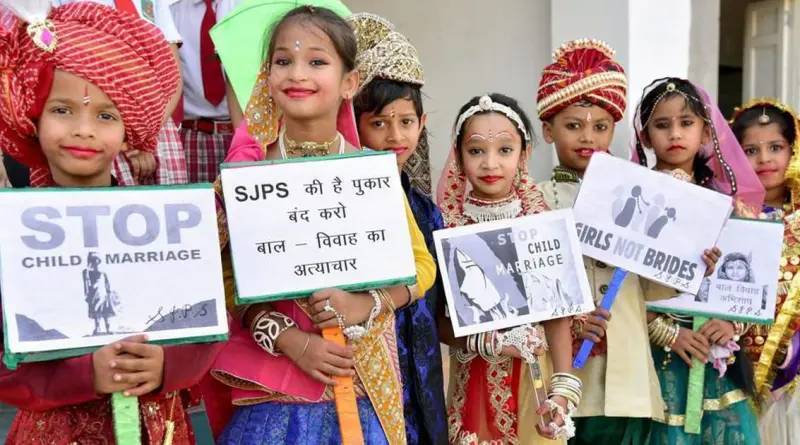The BJP has expelled its media chief Naveen Kumar Jindal and suspended a prominent spokesperson, Nupur Sharma, for making insulting remarks about the marriage of the Prophet Mohammed. This followed protests from all major Islamic countries. Many of Sharma’s supporters are apoplectic on the social media at her dismissal. Some portray Muslims in general as barbaric defenders of child marriage.
No, child marriage is not a Muslim specialty. It was common for centuries across regions and faiths, a compact between two families and not two individuals.
Parents would marry their children at age five or six. After the ceremony, the children lived apart with their parents till the girl attained puberty, after which she went to the boy’s house as wife. All prayed that she should be blessed with a son within a year (girls were not considered a blessing).
This was not just ancient tradition. It was the norm in India in the early 20th century. My own maternal aunt was married as a child. When she attained puberty, she got the shocking news that her boy-husband had died of disease. Hinduism forbade widow remarriage, though Islam encouraged it. Tradition required my aunt, as a child widow, to shave her head and wear a plain saffron sari to make herself unattractive to men and become, in effect, a lifelong household servant.
To save her from this fate, my grandfather entrusted my aunt to Sister Subbalakshmi, the great reformer who ran a sanctuary for child widows. She educated the widowed girls, enabling them to earn a living in an era when respectable women were not supposed to work outside their house. My aunt became a well-known doctor.
Through the centuries, little girls were married not only to little boys but also to grown men. This had the full sanction of tradition and religion. But it had horrendous outcomes.
Some of these are described in Katherine Mayo’s 1927 book Mother India. She recounts that in 1891, the legislative assembly of the British Raj debated reforms including a minimum marriage age. Hindu traditionalists strongly opposed any reform. The reformers presented evidence from doctors who had treated girls at hospital after terrible abuse by adult husbands. Here is a partial list.
1. Girl on the day after marriage. “Left femur dislocated, pelvis crushed out of shape, flesh hanging in shreds.”
2. Girl aged 9. “So completely ravished as to be almost beyond surgical repair. Her husband had two other wives and spoke fine English.
3. Girl aged 10. “Very small child entirely undeveloped physically.” Bleeding to death from the rectum after being sodomised by her 40-year-old husband.
4. Girl aged 9. “Lower limbs completely paralysed”.
5. Girl aged seven. “Living with husband. Died in great agony after three days in hospital.”
6. Girl aged 10. Condition “most pitiable.” After one day in hospital, her husband demanded her back for his “lawful use.”
7. Girl of 11. Great violence done to her person, will be a cripple for life. No use of lower extremities.
8. Aged about 10. “Crawled to hospital on her hands and knees. Has never been able to stand erect after her marriage.”
My body shook and eyes shut with horror on reading this. What deplorable brutality! All sanctified by tradition!
Mayo quotes another doctor. “I have never seen a creature so fouled. Her internal wounds were alive with maggots. For days after she got there, she lay speechless on her bed …. Meanwhile her husband is suing her marital rights and force her back into his possession. She is not yet thirteen years old.”
The doctors also speak of rampant venereal disease in little girls, contracted from their husbands. “Ninety nine percent of pelvic infection is of gonorrheal infection. Mayo recounts a conversation with a senior Brahmin official. He says if he has any female children, he will have to get them married by the age of five or seven. Otherwise, he will become an outcast. Fellow Brahmins will not eat, talk, or socialise with him, and his son will not find a decent wife.
Writing in 1927, Mayo says that child marriage is overwhelmingly a Hindu custom, but less common in Muslims. Yet she cites the 1921 census as saying virtually every woman in India was married by or immediately after puberty, and “cohabitation begins in every case with puberty.” This assessment does not distinguish between Hindus and Muslims. Child marriage was common across faiths.
So, Nupur Sharma, let none of us point fingers at others. All our ancestors across countries and faiths followed customs that horrify us today. Do not blame them overmuch for lower moral standards: these constantly change over time, and generations to come may be horrified by our moral standards today.
This article was originally published in The Times of India on June 12, 2022.


